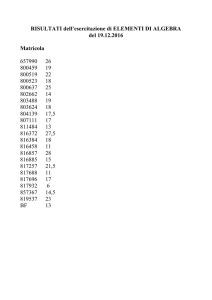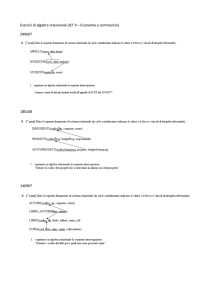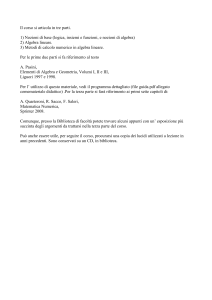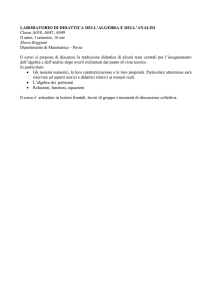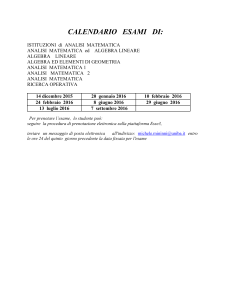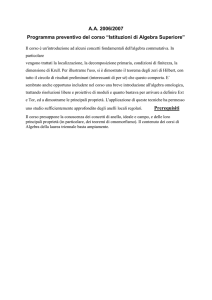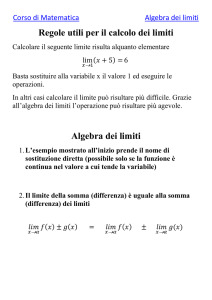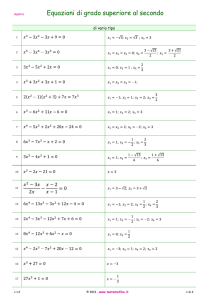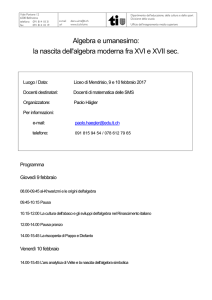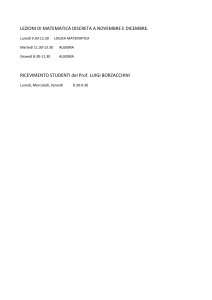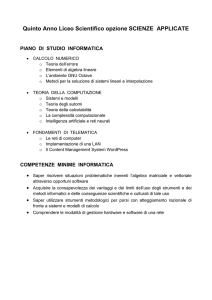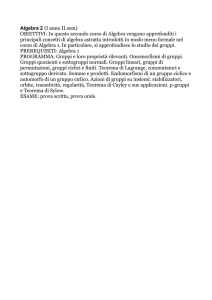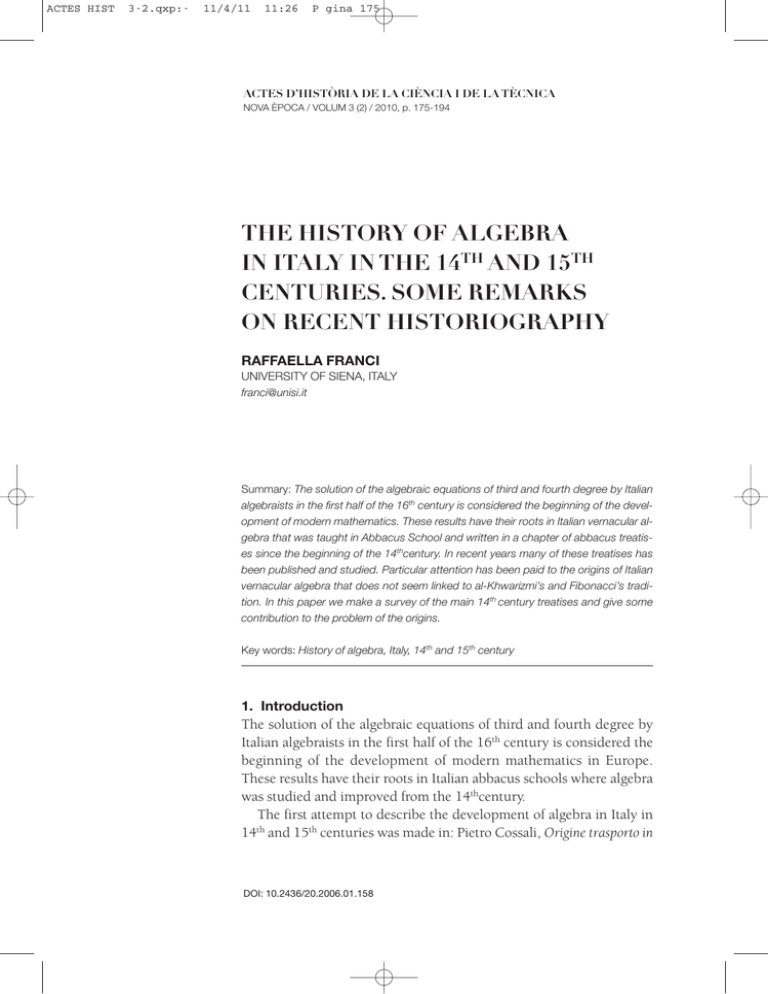
ACTES HIST
3-2.qxp:-
11/4/11
11:26
P gina 175
ACTES D’HISTÒRIA DE LA CIÈNCIA I DE LA TÈCNICA
NOVA ÈPOCA / VOLUM 3 (2) / 2010, p. 175-194
THE HISTORY OF ALGEBRA
IN ITALY IN THE 14TH AND 15TH
CENTURIES. SOME REMARKS
ON RECENT HISTORIOGRAPHY
RAFFAELLA FRANCI
UNIVERSITY OF SIENA, ITALY
[email protected]
Summary: The solution of the algebraic equations of third and fourth degree by Italian
algebraists in the first half of the 16th century is considered the beginning of the development of modern mathematics. These results have their roots in Italian vernacular algebra that was taught in Abbacus School and written in a chapter of abbacus treatises since the beginning of the 14thcentury. In recent years many of these treatises has
been published and studied. Particular attention has been paid to the origins of Italian
vernacular algebra that does not seem linked to al-Khwarizmi’s and Fibonacci’s tradition. In this paper we make a survey of the main 14th century treatises and give some
contribution to the problem of the origins.
Key words: History of algebra, Italy, 14th and 15th century
1. Introduction
The solution of the algebraic equations of third and fourth degree by
Italian algebraists in the first half of the 16th century is considered the
beginning of the development of modern mathematics in Europe.
These results have their roots in Italian abbacus schools where algebra
was studied and improved from the 14thcentury.
The first attempt to describe the development of algebra in Italy in
14th and 15th centuries was made in: Pietro Cossali, Origine trasporto in
DOI: 10.2436/20.2006.01.158
ACTES HIST
3-2.qxp:-
11/4/11
11:26
P gina 176
176
RAFFAELLA FRANCI
Italia, primi progressi in essa dell’Algebra (Cossali, 1797-99). In the first volume, Cossali illustrates the algebra chapter in Leonardo Pisano’s Liber abaci, which he correctly dates at
1202. Until then, in fact, historians of mathematics, including Montuclà, maintained that
Leonardo’s treatise was written in the fourteenth century. Before Cossali, the sources examined for charting the history of algebra in Italy were only printed texts. Thus, the first document examined by historians was the algebra chapter contained in Luca Pacioli, Summa de
Arithmetica Geometria Proportioni proportionalità (Pacioli, 1494).
The name Leonardo Pisano or Fibonacci was already known, for Pacioli attributed to him
much of what he wrote. However, Cossali was the first to read the algebra chapter of the Liber
abaci and to compare it with Pacioli’s treatment, by which he arrived at the hypothesis that
there were probably other algebra treatises between Pisano and Pacioli, although he was unable to find them. Nevertheless, he came to the conclusion that algebra was imported into
Europe from Arabic countries by Fibonacci, after which it spread from Pisa into Tuscany,
mainly in Florence, then into other Italian countries and later into other European countries.
This conclusion, only partially correct in the light of the richer documentation we have today, was accepted for about two centuries and half. In particular, it is necessary to point out
that Cossali completely ignored the Latin translations of Al-Khwarizmi’s Al-jabr, even though
he correctly recognized that algebra had its origins in this treatise (Franci, 1989).
A second important step in the historiography of algebra in the 14th and 15th centuries
was made by Guglielmo Libri in his Histoire des Sciences Mathematiques en Italie (Libri, 18381841). Libri’s reconstruction is based on many manuscripts he had seen in the libraries of
Paris and Florence and some of his own property. In the first volume Libri recognizes that
algebra entered into Europe by means of the Latin translations of Al-Khwarizmi’s Al-jabr and
publishes that of Gerardo da Cremona. In the second volume, he analyzes Fibonacci’s contributions and publishes the whole fifteenth chapter of Liber abaci, which is devoted to algebra. For the period immediately after Fibonacci, Libri affirms there were no followers in
the thirteenth century. On the other hand, he quotes some abbacists of the fourteenth century such as Paolo dell’Abaco, Paolo Gerardi and Giovanni Danti, whose treatises contain algebra. In the third volume, Libri illustrates Luca Pacioli’s contributions and mentions having seen some anonymous treatises in which third and higher degree equations are solved,
even though the solutions are wrong. In fact, he says that in these treatises the third degree
equations are solved with formulas similar to those for the second degree equations, while
for some other equations “des règles bizarres fondeés sur de faux principles” are given. He
further publishes two large excerpts from manuscripts of his own property where these alleged solutions are illustrated1 .
1.
These excerpts contain the wrong rules of Gerardi and the non numbered rules of Dardi, which we illustrate in a paragraph
below.
ACTES D’HISTÒRIA DE LA CIÈNCIA I DE LA TÈCNICA
NOVA ÈPOCA / VOLUM 3 (2) / 2010, p. 175-194
DOI: 10.2436/20.2006.01.158
ACTES HIST
3-2.qxp:-
11/4/11
11:26
P gina 177
THE HISTORY OF ALGEBRA IN ITALY IN THE 14TH AND 15TH CENTURIES. SOME REMARKS
177
The next important contribution to the medieval Italian historiography of algebra was
made by Baldassarre Boncompagni, who not only published all the treatises of Leonardo Fibonacci, but also illustrated many Italian manuscripts of the 14th and 15thcenturies containing important chapters on algebra, although without going into details (Boncompagni,
1854; 1857-1862).
It was only in the 1970s, in accordance with Boncompagni’s indications, that Gino Arrighi (1906-2001) began to study and to transcribe many important abbacus treatises, but
his focus was general and not only for algebra.
A virtually complete list of manuscripts containing algebra has been possible only from
nineteen-eighty, when Warren Van Egmond published a catalogue of Italian abbacus manuscripts (Van Egmond, 1980).
This was the situation when, about thirty years ago, Laura Toti Rigatelli and I began to be
interested in the history of the Italian medieval algebra. With the help of Van Egmond’s catalogue, we made a list of abbacus manuscripts containing a chapter on algebra, and with our
students we began to transcribe and to study many algebra treatises of the 14th and 15th centuries. Some of these texts have been published in the series Quaderni del Centro Studi di
Matematica Medioevale dell’Università di Siena. We subsequently wrote two surveys on the
most interesting things we had found in these manuscripts, paying more attention to the
new achievements as regards the Liber abaci (Franci & Toti Rigatelli, 1985; 1988).
Some years ago I again studied the fourteenth century algebra treatises, pointing out the
elements that differ from Al-Khwarizmi and Fibonacci (Franci, 2002) in order to make the
search for other possible sources easier.
The first algebra treatises to circulate in Italy were probably Gerardo’s Latin translation of
al-Khwarizmi’s Al-jabr and the third part of the fifteenth chapter of Liber abaci. The first Italian vernacular algebra treatises, however, are very different, so the question of finding their
sources arises. Before tackling this problem, it is opportune to give a glance to the environment in which algebra developed.
The algebra treatises of Italian Middle Ages are usually a chapter of a larger text named
abbacus treatise (trattato d’abaco); algebra was in fact taught in abbacus schools (scuole d’abaco) where people learned practical mathematics in order to employ it in business. The
teachers in these schools, known as abbacus masters (maestri d’abaco), often wrote treatises
which, although having many subjects in common with Leonardo’s Liber abaci, are different
from it in many respects (Franci, 2003a).
Only a part (about a third) of the surviving abbacus treatises contained a chapter devoted
to algebra. Algebra in fact was not strictly necessary to the mathematical education of merchants. Very few are the treatises entirely devoted to it. The majority of abbacus treatises consist of a collection of solved problems, sometimes preceded by a rule, only few having a longer
theoretical part. The treatment of algebra they contain obviously follows this style. The number of pages and the topics covered in the algebra chapters are variable, the typical contents
ACTES D’HISTÒRIA DE LA CIÈNCIA I DE LA TÈCNICA
DOI: 10.2436/20.2006.01.158
NOVA ÈPOCA / VOLUM 3 (2) / 2010, p. 175-194
ACTES HIST
3-2.qxp:-
11/4/11
11:26
P gina 178
178
RAFFAELLA FRANCI
bring: calculations with radicals, calculations with monomials and polynomials, rules for
solving algebraic equations, problems solved by algebra. Not all the subjects are always present; more often than not we have only a collection of solved problems preceded by a rule.
The main sources for the history of fourteenth-century Italian algebra are fifteen manuscripts belonging to the 14th century and three to the 15th century2. In recent decades, many
of the algebra treatises contained in these manuscripts have been transcribed and studied,
providing us with a better knowledge of the algebra of that period. Nevertheless, some important historical problems still remain to be solved, the first one being that of the sources.
2. The beginning of Italian vernacular algebra
We do not know of any Italian algebra treatises written before the fourteenth century; the
oldest actually date from the first decades of the 14th century and are as follows:
2.1. Paolo Gerardi’s Libro di ragioni
In 1978 Warren Van Egmond published what he believed to be “the earliest vernacular
treatment of algebra”; it refers to a chapter from the Libro di ragioni by Paolo Gerardi, written in Montpellier in 13283 and contained in the manuscript Magl. Cl. XI, 87 at the Biblioteca Nazionale of Florence (Van Egmond, 1978).
The chapter on algebra is the last one in the treatise (ff. 63r-70r). Gerardi’s treatment contains fifteen rules. Each rule, entitled in red “regolla della chosa“ or “delle chose“ or “choza”,
gives the algorithm to solve an equation. The rules concern the following equations4:
1. ax=b
4. ax2+bx= c
7. ax3=b
11. ax3=bx2+cx
12. ax3=bx+c (!)
15. ax3+bx2=cx
2. ax2=b
5. bx=ax2+c
8. ax3=兹苶
b
3. ax2=bx
6. ax2=bx+c
9. ax3=bx
13. ax3=bx2+c (!)
14. ax3=bx2+cx+d (!)
10. ax3=bx2
The equations marked by (!) are accompanied by a wrong rule: In fact, they are solved as
they if were ax2=bx+c in the first two cases and as ax2=bx+(c+d) in the last case. In what follows we refer to these rules as Gerardi’s wrong rules. The other equations are correctly
solved in an obvious way. Gerardi begins his treatment of algebra directly with the rules,
2.
A complete list is given in the Appendix.
3.
This information is found at the beginning of the treatise where we read “ .. le regole e il corso dell’ambaco facte per Pao-
lo Gerardi di Firenze , …, anno domini 1327 a dì 30 di gennaio secondo lo corso di Mompeslieri.” Recall that in those times the
year began on 25th March, thus according to our calendar the treatise was written in 1328.
4.
Here and in the sequel we write the equations using the modern symbolism.
ACTES D’HISTÒRIA DE LA CIÈNCIA I DE LA TÈCNICA
NOVA ÈPOCA / VOLUM 3 (2) / 2010, p. 175-194
DOI: 10.2436/20.2006.01.158
ACTES HIST
3-2.qxp:-
11/4/11
11:26
P gina 179
THE HISTORY OF ALGEBRA IN ITALY IN THE 14TH AND 15TH CENTURIES. SOME REMARKS
179
without explaining the meaning of the terms cosa, censo, cubo, which he uses to represent
the unknown and its powers. Each rule is followed by a problem, and simple rules for algebraic calculations are illustrated within the solution to the problems.
The first six rules are the same as those presented by al-Khwarizmi and Fibonacci, but
Gerardi’s treatment of algebra is quite different5. Not only the geometrical proofs are missing, but so is the introduction of algebraic quantities and rules of calculations, and most
parts of the problems are different. In particular, the fourth problem concerns a calculation
of interest, while the fifth deals with business trips.
2.2. Jacopo de Florentia’s Tractatus algorismi
In 2000 Jens Høyrup published what he claimed to be “the earliest vernacular algebra so far
known” (Høyrup, 2000, 2001, 2006). He affirms that the text he presents is a chapter from
Jacopo de Florentia’s Tractatus algorismi, written in Montpellier in 1307. Actually we know
of three copies of this treatise, one of the earliest Italian vernacular abbacus. They are contained in the manuscripts: Ricc. 2236, Biblioteca Riccardiana (Firenze); Ms 90, Biblioteca
Trivulziana (Milano); Vat. Lat. 4826, Biblioteca Apostolica Vaticana. The first one can be
dated from the beginning of the 14th century, the second and third from the beginning and
the mid of the 15th century, respectively. All of them begin:
Incipit tractatus algorismi compilatus a magistro Jacobo de Florentia apud Monte
Pesulanum anno domini millesimo trecentesimo septimo in mense septembrio.
The chapter on algebra is contained in the last manuscript only. This suggests that this
chapter on algebra might be a later interpolation, although from a comparative analysis of
the style of the various chapters, Høyrup concludes that algebra has a common authorship
with the other sections of the treatise, and so believes Jacopo’s algebra to be the earliest vernacular Italian algebra so far known.
Algebra occupies folios 36v-43r and is preceded by a series of geometrical problems,
then followed by some problems solved by arithmetical tools. Jacopo begins his treatment
with the six classical rules listed in the same order as Gerardi and followed by one or more
problems. After the 5th rule, he remarks:
But keep in mind that all the computations leading back to this rule can be answered
with two answers, but only some of them, and there are some for which you ought to
take one answer, and some the other.
Then he solves three problems, one for each case. After the 6th rule, he writes:
5.
We also remark that al-Khwarizmi and Fibonacci list the first three rules in a different order, that is, 3, 2, 1.
ACTES D’HISTÒRIA DE LA CIÈNCIA I DE LA TÈCNICA
DOI: 10.2436/20.2006.01.158
NOVA ÈPOCA / VOLUM 3 (2) / 2010, p. 175-194
ACTES HIST
3-2.qxp:-
11/4/11
11:26
P gina 180
180
RAFFAELLA FRANCI
Here I end the six rules combined with various examples, and begin the other rules
that follow the six mentioned above, as you will see.
The other rules concern the following equations and are not followed by problems.
7. ax3=b
10. ax3+bx2=cx
13. ax4=b
17. ax4+bx3=cx2
20. ax4+bx2=c
8. ax3=bx
11. bx2=ax3+cx
14. ax4=bx
18. bx3=ax4+cx2
9. ax3=bx2
12. ax3=bx2+cx
15. ax4=bx2
19. ax4=bx3+cx2
16. ax4=bx3
Like Gerardi, Jacopo does not previously introduce the terms of algebra he uses, which
are cosa, censo, cubo and censo di censo. He also teaches algebraical calculations during the solution of problems. Jacopo’s treatment resembles that of Gerardi, not only in the organization of the matter but also in the coincidence of many rules and problems. In particular, the
problems relative to the rules 1,3,4,5 are different only in the numerical data. Jacopo, however, does not present the wrong rules.
At this point a problem naturally arises: what are the sources of Jacopo’s and Gerardi’s algebras? Their treatment, in fact, follows a pattern very different from that of al-Khwarizmi
and Fibonacci, not only because they both omit the geometrical proofs of the rules and present equations of degree higher than two, but also because they apply algebra to solve different kinds of problems.
Høyrup affirms that the above-mentioned features of Jacopo’s and Gerardi’s algebras are
present in some Arabic texts. Nevertheless, the lack of any Arabism in their texts excludes a
direct derivation from Arabic sources. Thus, Høyrup develops a hypothesis of the influence
of a Romance speaking area, which in turn would have been influenced by Arabic sources.
The presence of the wrong rules in only one of the texts, however, suggests that Jacopo and
Gerardi might have drawn from different sources, even if they both wrote their treatises in
Montpellier. Even though we are not sure whether Jacopo was the first to present the twenty rules listed above, in what follows we refer to them as Jacopo rules.
In 2007 Høyrup edited the entire Jacopo treatise (Høyrup, 2007). In his long introduction, he reaffirms that Jacopo’s algebra is the earliest Italian vernacular algebra and repeats his
hypothesis on its origins. In a review of Høyrup’s book, Jeff Oaks presents many arguments
against Høyrup’s thesis that algebra in Vat. Lat. 4826 was already contained in Jacopo’s original treatise written in 1307 (Oaks, 2009). Oaks also contests Høyrup’s related thesis that Jacopo learned algebra not from the environment of Montpellier or Italy but from an unknown
“area?” located in or encompassing the Catalan region, which is not well proved. Before entering into the details of this question, it is necessary to illustrate the others surviving algebra
compilations that are almost contemporary to those of Gerardi and Jacopo.
ACTES D’HISTÒRIA DE LA CIÈNCIA I DE LA TÈCNICA
NOVA ÈPOCA / VOLUM 3 (2) / 2010, p. 175-194
DOI: 10.2436/20.2006.01.158
ACTES HIST
3-2.qxp:-
11/4/11
11:26
P gina 181
THE HISTORY OF ALGEBRA IN ITALY IN THE 14TH AND 15TH CENTURIES. SOME REMARKS
181
2.3. Tractato dell’arismetricha (Ricc. 2252)
The manuscript Ricc. 2252, Biblioteca Riccardiana of Florence, in the folios 1r-71v contains
a Tractato dell’arismetricha written in Pisa that by internal evidence can be dated at about
13206. After a first part, devoted to teaching the operations with natural numbers, the author begins to explain the rules for solving the problems, and after the rule of the three and
that of double false position he introduces “the rules of the greater thing with some examples by means of which all the problems are solved or can be solved”7. The sixteen rules,
numbered in red ink, coincide with the first sixteen of Jacopo, but they are presented in a
different order. After the first six, all the binomial of third and fourth degree are listed. Unlike the other texts we have examined, the first five rules are illustrated by numerical examples. Those concerning the 4th and 5th rule are: x2+10x=39 and x2+21=10x, which coincides
with those we find in al-Khwarizmi. Furthermore, while in the rules the author speaks of
“censi”, “cose” and “numeri”, in the examples the numbers are named “dragme”, which recall al-Khwarizmi’s “dirhams”. Rules 6, 7, 8, 9, 10, 16 are illustrated by a problem, which for
rules 8, 9, 10 is the same as that by Gerardi. Ten problems solved by algebra follow, and before each problem the author again writes in red ink the rule to which it refers; the rules are
1-2-3-4-6 on his list. These problems are different from those in Jacopo and Gerardi. In conclusion, it seems the author of this text has drawn his algebra from sources different from
those of Jacopo and Gerardi.
2.4. The manuscript 1754 of Biblioteca Statale of Lucca
Manuscript 1754, Biblioteca Statale of Lucca8, dated by internal evidence at about 1330,
contains an abbacus treatise in which, after a well organized treatment of the commercial
questions, we find a chapter devoted to algebra
The third book containing the rules of the thing with examples, with other good
problems that I have written by number and by root, as you will find9.
Sixteen rules follow, each preceded by the inscription “Reghola della chosa”. The rules
coincide with the first sixteen of Jacopo, but they are presented in the same order as Ricc.
2252. Only the first six rules are illustrated by a problem. These examples are similar to
those presented by Jacopo and Gherardi; sometimes they also coincide in the numerical
data. At the end of the rules we find another five problems solved by algebra.
6.
This interesting manuscript has yet to be studied by anybody.
7.
“Regole della cosa maggiore con certi esempi per li quali si fanno o si possono fare tutte le ragione”.
8.
The whole manuscript is edited in: Scuola Lucchese, 1973.
9.
“Terso libro e’ serae le regole della chosa con asempri, chon altre buone ragioni di vantaggio; le quali i’ òe scritti per nume-
ro e per radicie, sì chome voi troverete”.
ACTES D’HISTÒRIA DE LA CIÈNCIA I DE LA TÈCNICA
DOI: 10.2436/20.2006.01.158
NOVA ÈPOCA / VOLUM 3 (2) / 2010, p. 175-194
ACTES HIST
3-2.qxp:-
11/4/11
11:26
P gina 182
182
RAFFAELLA FRANCI
In the last part of the manuscript there is another chapter on algebra that begins:
Here we will begin the rules of aligibra amichabile, that is, of the thing as they are expressed in the vernacular, by which all the abbacus problems are solved and also many
of geometry10.
Next the six classical rules follow, each of them illustrated by a problem that differs from
that of the first part only in so far as numerical data. After the six rules we read the following remark:
These are 6 rules of aligibra amichabile, and by these six ways almost all the problems
are solved, by which one are able to bring back his problem to these rules. But there are
other rules of chubi and censi that are seldom needed because each problem can be
brought back to one of those six ways. Nevertheless, I will propose them to you without examples so that, if you need them, you shall know them11.
The rules that follow also coincide in the order with the 7-13 of Jacopo and are not followed by a problem.
The second version of algebra, while very similar to the first one, does not seem to be
drawn from the same source. Elements in favour of this claim are the different order in the
list of rules, the different numerical data in the problems, and finally the different name given to the discipline: “regola della cosa” in the first case and “aligibra amichabile” in the second case. We remark that this is the first occurrence of the name “aligibra amichabile” in the
vernacular tradition.
2.5. Some conclusions
Analyses of the algebra treatises we have made above enable us to tackle two problems concerning the origins of Italian vernacular algebra:
(1) What is the first Italian algebra treatise?
(2) What are its sources?
As regards problem (1), we recall that there are two candidates: Gerardi in Van Egmond’s
opinion and Jacopo in Høyrup’s opinion. Høyrup’s claim is based on the belief that the al-
10.
“ Quie inchomincieremo le regole dell’aligibra amicabile, ciò della chosa sono dette volgarmente; per le quali tutte le que-
stioni dell’anbacho se n’asolveno e ancho molte di giemetria”.
11.
“Queste sono 6 reghole dell’aligibra amicabile, e per questi 6 modi quaçi tutte le ragioni s’asolvono a chi sa indugiare la sua
ragione a questi modi. Ma sono anchora altre regole di chubi e de’ ciensi le quali rade volte biçogniano in però che ogni ragione
si puote indugiare ad alcuno di questi 6 modi ma nondimeno io te le porrò quelle sensa gli asempri acciò se pure ti biçognassero, che tu le sappi”.
ACTES D’HISTÒRIA DE LA CIÈNCIA I DE LA TÈCNICA
NOVA ÈPOCA / VOLUM 3 (2) / 2010, p. 175-194
DOI: 10.2436/20.2006.01.158
ACTES HIST
3-2.qxp:-
11/4/11
11:26
P gina 183
THE HISTORY OF ALGEBRA IN ITALY IN THE 14TH AND 15TH CENTURIES. SOME REMARKS
183
gebra chapter in the 15th century copy of Jacopo’s treatise was already present in the original. As I stated above, Oaks contests this assertion and I fully share his arguments. I further
believe that not even Gerardi’s treatise may be the first one. Indeed, in my opinion the solution to problem (1) is linked to the problem of dating manuscripts. For the most part, they
are dated by the watermark on the paper or by internal references to some dates contained
in astronomical or commercial problems. It is obvious that such dating has a range of error.
Now if we look at the manuscripts Ricc. 2252 and Lucca 1754 and take into account the
range of error in their dating, we may conclude that they are almost contemporary or perhaps earlier than Gerardi’s treatise. So we are not able to say which the first is. Furthermore,
they seem to be rather independent one from another. This conclusion is also important in
providing an answer to problem (2).
Although independent each from one another, the treatises examined above share some
common features that revert back to common sources that cannot be identified with Latin
translations of al-Kwarizmi or Fibonacci’s Liber abaci. It seems likely that they ultimately derive from Arabic sources; nevertheless, they are different from any Arabic treatise so far investigated by historians of mathematics. Since one of the characteristic of early Italian algebra is its extensive use in solving commercial problems, Høyrup develops the hypothesis
that its source may ultimately be found in muhalameth mathematics (Høyrup, 2007:159).
Unfortunately, this field of Arabic mathematic is still little studied, so no text containing an
algebra treatise similar to the Italian ones is available!
As regards the problem of how this algebra reached Italian abbacists, we have already
mentioned how Høyrup arrived at the hypothesis of the influence of a Romance speaking
area, which in its turn would have been influenced by Arabic sources, and how he further
located this area in the Catalan region. He bases his hypothesis on the conviction that Jacopo’s and Gerardo’s algebras are the earliest in Italian, and therefore form the basis of the
whole subsequent Italian production. If we take into consideration the analysis of the algebra treatises made above, and what we have said about the dating of the manuscripts, it is
evident that Høyrup’s premise is false.
In the light of what we currently know, I believe that we can only conclude that in the first
decades of the 14th century a knowledge of algebra independent from al-Khwarizmi and Fibonacci was widespread in Tuscany, and that its main characteristics are the solution of
equations of degree greater than two as well as the application to solve commercial problems, whose origins are probably Arabic. However, we are absolutely unaware of the way in
which this algebra reached Italy.
3. Dardi’s Aliabraa-Argibra
The problem of the sources for Italian algebra becomes even more complicated if we look at
the first Italian vernacular treatise entirely devoted to this subject. This is entitled AliabraaArgibra and was written in 1344 by Master Dardi of Pisa. So far five copies of Aliabraa are
ACTES D’HISTÒRIA DE LA CIÈNCIA I DE LA TÈCNICA
DOI: 10.2436/20.2006.01.158
NOVA ÈPOCA / VOLUM 3 (2) / 2010, p. 175-194
ACTES HIST
3-2.qxp:-
11/4/11
11:26
P gina 184
184
RAFFAELLA FRANCI
known. They are contained in the manuscripts: Chigi M.VIII.70 (c.1395), Biblioteca Apostolica Vaticana; I.VII.17 (c.1470), Biblioteca Comunale of Siena; Ash 1199 (c.1495), Biblioteca Mediceo-Laurenziana of Florence, Heb.1022 (1473, d), Bibliothèque Nationale of
Paris; Arizona State Library of Tempe (USA) (sec. XV). The first three copies are anonymous,
while the last copy gives us the name of the author and the date of compilation of the treatise. Furthermore, it was the point of departure for the translation into Hebrew contained in
the Paris manuscript. The translator was Mordechai Finzi of Mantova, who is also well
known for his translation into Hebrew of Abu Kamil’s Algebra. The three Italian copies are
almost identical; the first was written in a vernacular of Northern Italy, while the other two
are in a Tuscan vernacular (Van Egmond, 1983; Maestro Dardi, 2001).
In the introduction, the author explains that “the title of the book is called Aliabraa in Arabic, which in the vernacular means uncovering of a subtle matter”. Next he shortly presents
the content of the treatise and defines the terms cosa, censo, cubo, censo di censo. After a chapter
devoted to calculations with radicals, the algebra treatise begins. It is divided into two parts.
In the first part the classical six equations of first and second degree are presented, together with geometrical proofs and some simple rules for calculating with the unknown and
its powers. This part resembles al-Khwarizmi. The second part is on the other hand highly
original. It contains 198 rules, 194 of which are numbered, while the other four are not.
Each rule is followed by one or more problems.
We do not include the list here, but confine ourselves to remarking that the equations are
obtained by combining in different ways the following terms: a, ax, ax2, ax3, ax4,√a, √ax,
√ax2, √ax3, √ax4, 3√a, 3√ax, 3√ax2, 3√ax3, 3√ax4, where “a” is a positive integer. In the main,
Dardi limits himself to cases with only two or three terms, and only in seventeen cases does
he treat equations with four or more terms. It seems important to remark the presence of
equations like ax4+bx2=c and ax6+bx3=c. Almost all the proposed equations are reduced to
one of the six first cases or to a binomial equation like axn=b, 2≤n≤12, either by substitution
or by rising to an appropriate power. The sample problems for the numbered rules are all
one of the following types: Divide 10 into two parts such that..., Find one (or two or three or four)
numbers such that... The terms of the problems are always such that the equations are obtained quickly.
Between chapters 182 and 183, four non-numbered rules are inserted, and this is perhaps one of the most interesting parts of the treatise. The author warns the reader that, unlike the others, these rules are not as generally valid, since as he says the rules presented are
valid only for equations which come from problems like those proposed. In these cases, as
well as in the others, Dardi writes down the rule without any explanation about the way it
is obtained. The equations in question and relative solving rules are
( i) ax3+bx2+cx=d
(ii) ax4+bx3+cx2+dx=e
x=3√((c/b)3+d/a) – c/b
x=4√((d/b)4+e/a) -√(d/b)
ACTES D’HISTÒRIA DE LA CIÈNCIA I DE LA TÈCNICA
NOVA ÈPOCA / VOLUM 3 (2) / 2010, p. 175-194
DOI: 10.2436/20.2006.01.158
ACTES HIST
3-2.qxp:-
11/4/11
11:26
P gina 185
THE HISTORY OF ALGEBRA IN ITALY IN THE 14TH AND 15TH CENTURIES. SOME REMARKS
√(( —2ac ) + —ea ) +4ab— – √2b—d
4
(iii) ax4+dx=bx3+cx2+e
x=
(iv) ax4+cx2+dx=bx3+e
x=
185
2
√(( —2ac ) + —ea ) +4ab— – √2b—d
4
2
The problems illustrating rules (i) and (ii) are relative to a calculation of interest, the others ask us to divide 10 into two parts, x, 10-x, such that
(x(10-x))/(2x-10)=√N, with N a given natural number12.
While the first part of Aliabraa is very close to al-Khwarizmi’s text, borrowing its examples and proofs, nothing is known about possible sources for the second part.
4. The algebra treatises of the second part of the 14th century
The algebra treatise contained in codex Ricc. 2263 of Biblioteca Riccardiana of Florence,
dated by watermark about 1365 (Anonimo, 1994), is very interesting, because here we find
for the first time Gerardi’s and Jacopo’s rules listed together. This text, entitled Trattato dell’alcibra amuchabile, begins with the rules of signs and rules to operate with radicals. The
next twenty-four equations follow. The part concerning the first six rules resembles Jacopo’s
word for word. Rules 7 to 13 coincide, although in a different order, with that so numbered
in Gerardi, and they are also followed by the same problems. Rules 14 to 24 coincide with
Jacopo’s last ten rules and are not followed by a problem. In conclusion, this set of rules is
almost the exact union of Jacopo and Gerardi. In fact, only Gerardi’s third wrong rule and
Jacopo’s 10th rule are missing. Forty problems solved by algebra subsequently follow, most
of them of business type. It is interesting to point out that in some of these problems the
rules for operating with the algebraic fractions are illustrated (Franci, 1992: 325-334).
The other Italian surviving algebra treatises that we know from the second part of the 14
century date back to the last decade of the century. Many of them share a common feature;
they present a greater number of equations than Gerardi and Jacopo. Many of them like
Fond. Prin. II. III. 198, 2Qq E13, Ricc. 2252 (ff 160r-169r), Pal. 312 (Anonimo, 1998), include Gerardi’s wrong rules and Dardi’s non-numbered rules followed by the same problems. The authors of these treatises appear to have copied from other texts without criticism. They seem to be completely unaware that some rules were wrong and others valid
only for a limited class of problems.
12.
Guglielmo Libri owned what is now the Ashburnham manuscript, and at the end of note XXXI in the third volume of his “His-
toire…” he prints the section concerning the four special equations. For a good analysis of these equations see Van der Waerden, 1985: 47-52.
ACTES D’HISTÒRIA DE LA CIÈNCIA I DE LA TÈCNICA
DOI: 10.2436/20.2006.01.158
NOVA ÈPOCA / VOLUM 3 (2) / 2010, p. 175-194
ACTES HIST
3-2.qxp:-
11/4/11
11:26
P gina 186
186
RAFFAELLA FRANCI
Very different is the quality of the chapter on algebra, included in the manuscript Fond.
Prin. II.V.152 of Biblioteca Nazionale of Florence, written by an anonymous Florentine master, in the last ten years of the fourteenth century. Here in fact we find an interesting improvement on the solution of the third degree equations. Algebra occupies folios 145r to
180v (Anonimo, 1988). After a very detailed exposition of calculations with polynomials,
twenty-two rules follow that coincide with the twenty by Jacopo plus ax4+c=bx2, ax4=bx2+c,
which are the logical companions of the last rule in Jacopo’s list. Each rule is explained by
two or three problems. At the end of this part we read the following remark
Here we explain the 22 rules of algebra with some examples. Now I will continue
with some rules besides these, which are fine. And from this you will understand as
many rules you could make on these equations, although it is difficult to make them13.
The rules are relative to the following equations:
23. ax3+bx2=c ,
24. ax3= bx2+c,
25. ax3+c=bx2.
The author claims that the solution to 23 is, in modern notation, x=y-(b/3a), where y is
such that y3=3(b/3a)2y-(c/a+2(p/3a)3). In the examples he solves, the last equation is solved
by trial and error. The rules to solve the equations 24 and 25 are similar except for obvious
change of signs. In each case the rule is followed by a numerical example and by a problem.
We remark that what the anonymous author does is to turn an equation like x3+px2+q=0
into y3+p’y+q’=0 by the substitution y=-p/3. However, he lacks a formula to solve the latter.
Rather he solves it by trial and error in any particular case (Franci, 1985).
It is very interesting to remark that the author of the treatise claims to be the inventor of
the rules to solve the equations 23-24-25.
Since we have proved these three rules besides the twenty two, it is possible that
many rules exist, but so far we have made no more, so I will leave some space so that if
at another time we wish to make more rules we can write them here14.
The first and third of the afore-mentioned rules are also presented in the almost contemporary manuscript Conv. Sopp. G.7.1137 (ff. 150v-151v), Biblioteca Nazionale of Florence.
The problems that illustrate these rules are different from those of the previous text.
13.
Qui abbiamo chonpiuto di dichiarare le 22 reghole del’algibra, chon alcuni asenpri, ora seguiterò alcuna regola fuori di que-
ste che sono belle e per quelle chonprenderai chome molte regole si potrebono fare sopra a questi uguagliamenti ma sono d’asai sentimento a volerle fare.
14.
“Sichome abiamo dimostrate queste tre regole oltre alle 22, è posibile che asai regole siano, onde non abiendo per ora
fatte più lascerò di spazio per insino a la metà del quaderno a ciò che, se altra volta più reghole facessimo si possano seghuire.”
<f. 166r>.
ACTES D’HISTÒRIA DE LA CIÈNCIA I DE LA TÈCNICA
NOVA ÈPOCA / VOLUM 3 (2) / 2010, p. 175-194
DOI: 10.2436/20.2006.01.158
ACTES HIST
3-2.qxp:-
11/4/11
11:26
P gina 187
THE HISTORY OF ALGEBRA IN ITALY IN THE 14TH AND 15TH CENTURIES. SOME REMARKS ON RECENT
187
Until now we have not found these rules in any other treatise. Nevertheless, we must remark
that in the 15th chapter of Ars Magna (1545), in order to solve the equation ax3+bx2=c, Girolamo Cardano transforms it exactly in the same way as the anonymous abbacists of the 14th
century. The great difference is that Cardano knew how to solve the transformed equation.
From the analysis made until now it might seem that the 14th century abbacists were
completely unaware of the treatment of algebra by al-Khwarizmi and Fibonacci. This is not
so, however. In fact, in the manuscript MA 334 (c. 1400), Biblioteca Angelo May of Bergamo, at ff. 63r-66r, we indeed find a translation into the Venetian vernacular of the section
of Liber abaci containing the geometrical proofs of the second degree compound rules, followed by a treatment of algebra that follows the pattern we have seen so far. In this section,
we find twenty five rules each illustrated by a problem. The first eighteen rules coincide
with those of Ricc. 2263. Next there are the four non-numbered rules by Dardi, followed by
ax4+bx2=c, ax4+c=bx2, ax4=bx2+c . Gerardi’s wrong rules are not included.
An identical treatment of algebra, including the translation of the geometrical proofs
from Liber abaci, is contained in ff. 13r-30v of Magl. XI. 120 (c. 1400), Biblioteca Nazionale
of Florence, which is written in a Tuscan vernacular.
The 14th century abbacists’ knowledge of the Latin origins of algebra is also evidenced by
a translation into the vernacular of Gerardo da Cremona’s Latin translation of al-Khwarizmi’s Al-jabr, contained in ff. 84r-107v of the manuscript Fond. Prin. II. III. 198, Biblioteca
Nazionale of Florence, while the manuscript Urb. lat. 291 (c.1400), Biblioteca Apostolica
Vaticana, contains a vernacular translation of another Latin translation of Al-jabr (Franci,
2003b) and a translation of the third part of the fifteenth chapter of Liber abaci.
I believe that the study of Urb. Lat 291, until now ignored by the historians of medieval
algebra, may be of great interest. It seems in fact to be a compendium of the whole 14th-century Italian vernacular algebra. It presents a translation of the 14th chapter of Liber abaci (devoted to radicals), a translation into Italian of a Latin edition of the Al-jabr, a translation of
the third part of the 15th chapter of Liber abaci followed by other problems solved by algebra, a list of thirty five rules containing all the rules of Jacopo and Gerardi, and the four nonnumbered rules of Dardi followed by another set of problems solved by algebra.
5. Italian vernacular algebra of the fifteenth century
In the 15th century, algebra continues to be presented in appropriate chapters of abbacus treatises, and their contents are often copied word by word from texts of the previous century.
Many 15th century treatises continue to present the wrong rules of Gerardi, which proves that
their authors copied without criticism15. A very different matter are the algebra chapters con15.
In this regard, we remark that the first treatise by a Portuguese author that has come down to us containing a treatment
of algebra, namely Bento Fernandes’s Tratado da arte de arismetrica (1555), contains a chapter on algebra quite similar to that
of the above quoted manuscript Pal 312 including Gherardi’s wrong rules. See: Silva, M.C., 2008.
ACTES D’HISTÒRIA DE LA CIÈNCIA I DE LA TÈCNICA
DOI: 10.2436/20.2006.01.158
NOVA ÈPOCA / VOLUM 3 (2) / 2010, p. 175-194
ACTES HIST
3-2.qxp:-
11/4/11
11:26
P gina 188
188
RAFFAELLA FRANCI
tained in some large treatises that may be considered as encyclopedias of the mathematics
taught in the abbacus schools, they are entitled Praticha d’arismethrica and are contained in
the manuscripts L.IV. 21, Pal. 573, Ott. lat. 330716. The first one was written by Benedetto da
Firenze, the others by an anonymous Florentine master who claims to be a student of a certain Agostino Vaiaio. The long chapters devoted to algebra in these treatises are very similar17.
They are divided into many sections. The first one has a general and introductory character
and begins with a translation into the vernacular of the first part of the Latin version of Aljabr by Gerardo da Cremona. A list of rules for solving third and fourth degree equations follows, all the equations being binomial or trinomial equivalent to a second degree equation.
There are no traces of Gerardi’s wrong rules or Dardi’s non-numbered rules. This section ends
with the solution of many simple problems. Each of the following parts is devoted to the
presentation of a series of problems drawn from treatises of other authors, for which biographical notes are also given. Leonardo Pisano, Antonio de’ Mazzinghi (sec. XIV) and Giovanni di Bartolo (sec. XV) are present in all the treatises, while M° Biagio (sec. XIV) appears only
in L.IV.21 and M° Luca (sec. XV) and Agostino Vaiaio (sec. XV) only in the other two texts.
These treatments of algebra not only show that their authors had a sound historical
knowledge of the subject, but also that they exerted a criticism. They in fact deliberately
omitted to write out the wrong rules for the third degree equations, as emerges from the following remark by M° Benedetto:
We might write certain equations that were given for the third powers in ancient
times, but these rules are very obscure and more doubts are in the solutions than in the
enunciations, so those given are sufficient18.
In spite of M° Benedetto’s warning, many abbacists of the 15th century include the wrong
rules in their texts. Among them we may recall Raffaello Canacci, who has left to us two treatises entirely devoted to algebra contained in the manuscripts Ricc. 2265 (c.1490), Biblioteca Riccardiana of Florence, and Pal. 567 (c. 1495), Biblioteca Nazionale of Florence19.
Canacci’s treatment includes the geometrical proofs for the second degree equations and
calculations with radicals, monomials and polynomials. His list of sixty five rules includes
Gerardi’s wrong rules and Dardi’s four non-numbered rules, illustrated by the same problems we find in the texts of the ancient authors.
16.
For a good description of the content of these treatises see: Arrighi, 1965; 1967; 1968. The three papers are also reprin-
ted in Arrighi, 2004.
17.
The algebra chapter in L.IV.21 has been completely edited in the following publications: M° Benedetto da Firenze, 1982;
M° Biagio, 1983; M° Antonio de’ Mazzinghi, 1967; Giovanni di Bartolo, 1982; Leonardo Pisano, 1984.
18.
“… certe aguagliationi le quali anticamente sopra e chubi davano si potrebbero scrivere , ma sono regole molto offuscate
et in più dubi si risulta nella solutione che nel proporro del chaso, queste date adunque bastino, …” <L.IV.21, f. 430v.>
19.
The last manuscript has been completely edited in: Procissi, 1954 and Canacci, 1983.
ACTES D’HISTÒRIA DE LA CIÈNCIA I DE LA TÈCNICA
NOVA ÈPOCA / VOLUM 3 (2) / 2010, p. 175-194
DOI: 10.2436/20.2006.01.158
ACTES HIST
3-2.qxp:-
11/4/11
11:26
P gina 189
THE HISTORY OF ALGEBRA IN ITALY IN THE 14TH AND 15TH CENTURIES. SOME REMARKS
189
The manuscript Ital 578, Biblioteca Estense of Modena, contains the only original treatment of algebra in Italy from the 15th century (Anonimo (sec.XV), 1986). Algebra occupies
the folios from 5r to 18v. The treatment begins with a list of the powers of the unknown,
which range from simple numbers to an unknown of ninth degree, which are denoted by
the following abbreviations : N (number), C (x), Z (x2), Q (x3), ZZ (x4), C di ZZ (x5), Z di Q
(x6), C di Z di Q (x7), Zdi ZZ (x8), Q di Q (x9), where C, Z, Q are the first letters of ‘Cossa’,
‘Zenso’and ‘Qubo’, which are the names of the first three powers of the unknown. The author associates one ‘grado’ (degree) to each term, beginning with 0 for N, 1 for C, 2 for Z,
and so on. The list of the powers is followed by an explanation of how to perform the four
basic operations with them. Here we find the first original contribution. In fact, as regards
multiplication and division, the author suggests that the result can be obtained by adding
or subtracting the degrees. The author’s originality also continues to reveal itself in listing
the equations; rather than giving a separate rule for every equation; he divides his equations
in eighteen basic types and gives one general rule that can be used to solve any equation of
that type. Thus, ax2+bx=c was included with ax3+bx2=cx, ax4+bx3=cx2, ax9+bx8=cx7 , in a
single rule.
We are unable to identify any possible sources of this anonymous author. We only remark that a similar treatment of algebra can be found in part three of Nicholas Chuquet’s
Triparty en la science des number, written in Lyon in 1484 (Chuquet, 1484).
However, the Modena algebra seems to have had almost no influence. We know indeed
of only one Italian algebra that can be connected to the same tradition. This is the algebra
chapter in the Libro di ragioni by Dionigi Gori, written in Siena in 1544 and contained in the
manuscript L.IV.22, Biblioteca Comunale of Siena (Gori, 1984).
The first abbacus treatises were printed in Italy at the end of the 15th century, the most
important of which was the Summa de Arithmetica Geometria Proportioni et Proportionalita,
written by Luca Pacioli and printed in Venice in 1494. The Summa contains a chapter on algebra that is the first algebra to be printed in Europe.
Pacioli’s treatment begins with a translation into the vernacular of the first part of the
third section of Chapter 15 from Liber abaci, which concerns the six classical equations of
first and second degree. Pacioli then makes some interesting remarks on the way the unknown is to be chosen in the solution of problems. After remarking that from the six classical cases it is possible to draw an infinite number of other cases of higher degree, Pacioli says
that until then there were no general rules for equations like ax4+bx2=cx, ax4+cx=bx2, but
concludes that perhaps the rules might be found in the future. Pacioli’s treatment of algebra
does not represent the deep, rich and complex tradition of investigation into the solutions
of trans-quadratic equations that we have examined. We believe that the following developments in algebra in Italy were influenced more by the rich handwritten tradition we have
described than by Pacioli’s treatise.
ACTES D’HISTÒRIA DE LA CIÈNCIA I DE LA TÈCNICA
DOI: 10.2436/20.2006.01.158
NOVA ÈPOCA / VOLUM 3 (2) / 2010, p. 175-194
ACTES HIST
3-2.qxp:-
11/4/11
11:26
P gina 190
190
RAFFAELLA FRANCI
6. Conclusions
From the analysis we have made of algebra treatises contained in the Italian manuscripts of
the fourteenth century that have come down to us, it emerges that in the first part of the century there were various traditions different from al-Khwarizmi and Fibonacci. In particular,
we have picked out three different traditions that we name by their first exponents: Gerardi, Jacopo and Dardi. The texts written by the first two authors are characterized by the
presence of equations of degree greater than two, and by the use of algebra also to solve mercantile problems, while Dardi’s treatise containing a list of 198 equations is more theoretical. Actually, we know of no previous Arabic or Latin text with these characteristics, so the
problem of the origins of the Italian algebraic tradition remains open. In the last part of the
14th century, we find instead a merging of all the above-quoted trends, and also a revival of
interest in al-Khwarizmi and Fibonacci. In the following century, the patterns of the algebra
chapters in the Italian abbacus treatises show no novelties except for Modena algebra, but
the 15th century abbacists considered the knowledge of algebra very important for determining their ability. The importance given to this discipline is also testified by the long historical chapters contained in the manuscripts L.IV.21, Pal. 573 and Ott. lat. 3307. The great
attention paid to algebra by Italian abbacists of the fourteenth and fifteenth centuries, and
their investigations into the solution of third and fourth degree equations, surely contributed to the diffusion of algebra and paved the way for the great achievements of the next
century, when Scipione dal Ferro, Niccolò Tartaglia, Girolamo Cardano and Ludovico Ferrari found the rules to solve these equations.
ACTES D’HISTÒRIA DE LA CIÈNCIA I DE LA TÈCNICA
NOVA ÈPOCA / VOLUM 3 (2) / 2010, p. 175-194
DOI: 10.2436/20.2006.01.158
ACTES HIST
3-2.qxp:-
11/4/11
11:26
P gina 191
THE HISTORY OF ALGEBRA IN ITALY IN THE 14TH AND 15TH CENTURIES. SOME REMARKS
191
APPENDIX20
Vat. Lat. 4826 (c. 1450), Biblioteca Apostolica Vaticana
Jacopo de Florentia, Tractatus algorismi (1307) ff.
1-59
<Algebra> ff. 36v-45v.
Conv. Sopp. G. 7. 1137 (c. 1395), Biblioteca Nazionale, Firenze
Libro delle ragioni d’abaco, ff. 1r-253r
<Algebra>, ff. 107r-109v
Reghole dell’alcibra mochabile, ff. 144r-151v.
Magl. Cl. XI, 87 (1328, d), Biblioteca Nazionale, Firenze
Paolo Gerardi, Libro di ragioni, ff. 1-70
Le regole dela cosa, ff. 63r-70r.
Chigi M. VIII. 170 (c. 1395) Biblioteca Apostolica Vaticana
<Dardi>, Aliabraa-Argibra, ff. 1r-112r.
Ms. 1754 (c. 1330), Biblioteca Statale, Lucca
Libro di molte ragioni d’abaco, ff. 1-87
Regola della chosa, ff. 50r-52r
<Algebra> ff. 81r-81v.
Ricc. 2252 (s. XIV), Biblioteca Riccardiana, Firenze
(i) Tractato dell’aritmetica (c.1320), ff. 1-71
Regole della cosa, ff. 25r-30r
(ii) Regole dell’algebra (c.1400), ff. 160r-169r.
Ricc. 2263 (s. XIV), Biblioteca Riccardiana, Firenze
Trattato dell’alcibra amuchabile (c.1365), ff. 24r50v.
Plut. 30, 26 (1370, d), Biblioteca Mediceo-Laurenziana, Firenze
Giovanni de’ Danti, Tractato dell’algorismo, ff. 1r-28r.
Per regola del’argibra e per modo di propositione, ff.
20v-21v.
L. IX. 28, (1384, d), Biblioteca Comunale, Siena
Gilio, <Aritmetica e geometria> ff. 1-216
Regole della cosa, ff. 37r-45r.
Fond. prin. II. III. 198 (s. XIV), Biblioteca Nazionale,
Firenze
(i) Libro d’insegnare arismetrica (1390, d), ff. 3r-59v
Delle regole delle cose, ff. 47r-55r
(ii) Liber de algiebra e almuchabila (c. 1390), ff. 86r107v.
Fond. fond. II. V. 152 (c. 1390), Biblioteca Nazionale, Firenze
Tratato sopra l’arte dell’arismetrica, ff. 1r-180
<Calcolo algebrico>, ff. 145r-153r
Le reghole della cosa, ff. 153v-166r
<problemi risolti con l’algebra>, ff. 169v-180v.
20.
2Qq E 13 (1398, d), Biblioteca Comunale, Palermo
Libro merchatantesche, ff. 1r-76v
L’algibra mochabile, ff. 39v-50v.
MA 334 (c.1400) Biblioteca Civica ‘Angelo Mai’, Bergamo
III. <Maestro Nicheletto. Zibaldone di matematica>
(i) (63r-66r) Le chonpoxiçion del açebra
(ii) (78r-77v) Li chapitoli del Açebra.
Magl. Cl. XI, 120 (c.1400), Biblioteca Nazionale, Firenze
(i) <Capitoli d’algebra>, ff. 1r-7r
(ii) M°Antonio da Firenze, Regole del’arzibra, ff. 7v-10v
(iii) <Algebra>, ff. 13r-30v.
Pal . 312 (c.1400), Biblioteca Palatina, Parma
Anonimo, Libro di conti e mercatantie, ff. 1-60
Le regole e asempri della Gibra mocabile, ff. 43v-52r
Urb. Lat. 291 (c.1400) Biblioteca Vaticana,
Anonimo,< Trattato di algebra e geometria>
Fiore de fiori, 1r-33v
Algebra e almucabala, 34rPal. 573 (c.1460), Biblioteca Nazionale, Firenze
Anonimo, Trattato di praticha d’arismetricha, ff. 1492
La diecima parte di questo trattato dicente della regola d’algebra amuchabale,
ff. 391r-489v.
L. IV. 21 (1463, d), Biblioteca Comunale, Siena
M°Benedetto, Trattato di praticha d’arismetricha, ff.
1-506
El tredecimo libro di questo trattato nel quale si contiene chome e in che modo s’asolvono e chasi per la
regola de algebra amuchabale, ff.368r-388r
A full palaeographic description of the listed manuscripts can be found in Van Egmond, 1980.
ACTES D’HISTÒRIA DE LA CIÈNCIA I DE LA TÈCNICA
DOI: 10.2436/20.2006.01.158
NOVA ÈPOCA / VOLUM 3 (2) / 2010, p. 175-194
ACTES HIST
3-2.qxp:-
11/4/11
11:26
P gina 192
192
Lo quarto et decimo libro di questo trattato nel quale
si dimostrano chasi exenplari alla regola dell’algibra
secondo che scrive Maestro Biaggio, ff. 388v-408r
El quindecimo libro di questo trattato nel quale si
chontenghono chasi d’alquanti maestri antichi, ff.
408v-474v.
Ott. Lat. 3307 (c.1465), Biblioteca Apostolica Vaticana
Trattato di praticha d’arismetricha, ff. 1r-343r
RAFFAELLA FRANCI
Decima parte contiene alcuna chosa d’algebra, ff.
304r-342v.
Ital. 578 (c.1485), Biblioteca Estense, Modena
Qui comincia l’agibra, ff. 5r-18v
Ricc. 2265 (c. 1490), Biblioteca Riccardiana, Firenze
Raffaello Canacci, Vilume dell’algibra, ff. 1r-211r.
Pal. 567 (c. 1495), Biblioteca Nazionale, Firenze
Raffaello Canacci, La regola dell’algibra, ff. 1r-90v.
References
ANONIMO (sec.XV) (1986), Della radice dei numeri e
metodo di trovarla ( Trattatello di algebra e geometria),
Parte prima, a cura di VAN EGMOND, Warren, Quaderni del Centro Studi della Matematica Medioevale
n°15, Siena, Università di Siena.
ANONIMO (1988), Il trattato d’algibra (ms Fond.
prin.II.V.152), a cura di FRANCI, Raffaella, PANCANTI,
Marisa, Quaderni del Centro Studi della Matematica
Medioevale, n°18, Siena, Università di Siena.
ANONIMO (sec. XIV) (1994), Trattato dell’alcibra amuchabile, dal codice Ricc. 2263 della Biblioteca Riccardiana di Firenze, a cura e con introduzione di SIMI,
Annalisa, Quaderni del Centro studi della Matematica
Medioevale, n° 22, Siena, Università di Siena.
ANONIMO (1998), Libro di conti e mercatanzie, a cura
e con introduzione di GREGORI, Silvano e GRUGNETTI, Lucia, Parma, Università degli Studi di Parma.
BONCOMPAGNI, B. (1857-1862), Scritti di Leonardo Pisano matematico del secolo decimo terzo. I.
Il Liber abbaci. II. Pratica geometriae et Opuscoli,
Roma.
BONCOMPAGNI, B. (1854), Intorno ad alcune opere
di Leonardo Pisano matematico del secolo decimoterzo, Roma.
CANACCI, R. (1983), Ragionamenti d’algebra. I problemi, a cura e con introduzione di PROCISSI, Angiolo, Quaderni del Centro Studi della Matematica Medioevale n°7, Siena, Università di Siena, 1983.
CHUQUET, Nicholas (1484), Triparty en la science
des nombres, Lyon.
COSSALI, P. (1797-99), Origine trasporto in Italia, primi progressi in essa dell’Algebra, Parma, 2 vols.
ARRIGHI, G. (1965), “Il codice L.IV.21 della Biblioteca
degl’Intronati di Siena e la “Bottega dell’abaco a santa Trinita” in Firenze”, Physis , 7, 369-400.
FRANCI, R. (1985), “Contributi alla risoluzione delle
equazioni di 3° grado”. In: FOLKETS, Menso; LINDGEN, Uta (eds), Mathemata, Steiner Verlag, Stuttgart,
221-228.
ARRIGHI, G. (1967), “Nuovi contributi per la storia
della matematica a Firenze nell’età di mezzo: il codice Palatino 573 della Biblioteca Nazionale di Firenze”,
Istituto Lombardo. Accademia di Scienze e Lettere.
Rendiconti, Classe di scienze (A), 101, 395-437.
FRANCI, R. (1989), “Pietro Cossali storico dell’algebra”. In: BARBIERI F. & CATTELANI F. (eds.), PIETRO
RICCARDI (1828-1898) e la storiografia delle matematiche in Italia, Modena, Università degli Studi di
Modena, 199-217.
ARRIGHI, G. (1968), “ La matematica a Firenze nel
Rinascimento. Il codice Ottoboniano latino 3307
della biblioteca Apostolica Vaticana”, Physis, 10, 70-82.
FRANCI, R. (1992), “Des fractions arithmétiques aux
fractions algébriques dans les trattati d’abaco du XIVe
siècle”. In: BENOIT, Paul; CHEMLA, Karine; RITTER,
Jeremy (eds), Histoire de fractions, fractions d’histoire, Basel, Birkhäuser Verlag, 325-334.
ARRIGHI, G. (2004), La matematica dell’Età di Mezzo.
Scritti scelti, a cura di BARBIERI, Francesco; FRANCI, Raffaella; TOTI RIGATELLI, Laura (eds), Pisa, Edizioni ETS.
FRANCI, R. (2002), “Trends in fourteenth-century Italian Algebra”, Oriens-Occidens, 4, 81-105.
ACTES D’HISTÒRIA DE LA CIÈNCIA I DE LA TÈCNICA
NOVA ÈPOCA / VOLUM 3 (2) / 2010, p. 175-194
DOI: 10.2436/20.2006.01.158
ACTES HIST
3-2.qxp:-
11/4/11
11:26
P gina 193
THE HISTORY OF ALGEBRA IN ITALY IN THE 14TH AND 15TH CENTURIES. SOME REMARKS
FRANCI, R. (2003a), “Leonardo Pisano e la trattatistica dell’abaco”, Bollettino di Storia delle Scienze Matematiche, 23/2, 33-54.
FRANCI, R. (2003b), “Una traduzione in volgare dell’Al-jabr di al-Khwarizmi (ms. Urb. lat. 291 Biblioteca
Apostolica Vaticana)”. In: FRANCI, Raffaella; PAGLI,
Paolo; SIMI, Annalisa (eds.), Il sogno di Galois, Siena,
Università di Siena, 19-49.
FRANCI, R.; TOTI RIGATELLI, L. (1985), “Toward a history of algebra from Leonardo of Pisa to Luca Pacioli”, Janus, 72, 17-82.
FRANCI, R.; TOTI RIGATELLI, L. (1988), “Fourteenthcentury Italian algebra”. In: HAY, Cinthia (ed.), Mathematics from Manuscript to Print 1300-1600, Clarendon Press-Oxford, 11-29.
GIOVANNI DI BARTOLO (1982), Certi chasi nella trascelta a cura di Maestro Benedetto (secondo la lezione del Codice L.IV.21 (sec.XV) della Biblioteca degl’Intronati di Siena), a cura e con introduzione di
PANCANTI, Marisa, Quaderni del Centro Studi della
Matematica Medioevale, n° 3, Siena, Università di
Siena.
GORI, Dionigi (1544), Libro di ragioni, Siena [contained in the manuscript L.IV.22, Biblioteca Comunale of
Siena].
GORI, Dionigi (1984), Libro e trattato della praticha
d’alcibra ( dal codice L.IV.22 della Biblioteca Comunale di Siena), a cura e con introduzione di TOTI RIGATELLI, Laura, Quaderni del Centro Studi della Matematica Medioevale n°9, Siena, Università di Siena.
HØYRUP, J. (2000), “Jacobus de Florentia, Tractatus
algorismi (1307), the chapter on algebra (vat. Lat.
4826, fols 36v-45v)”, Centaurus, 42, 21-69.
HØYRUP, J. (2001), “The founding of Italian vernacular algebra”. In : Commerce et mathematiques du
moyen âge à la reinassance, Toulouse, Editions du
C.I.S.H.O., 129-156.
HØYRUP, J. (2006), “Jacopo da Firenze and the beginning of Italian vernacular algebra”, Historia Mathematica, 33, 4-42.
HØYRUP, J. (2007), Jacopo da Firenze’s Tractatus
Algorismi and Early Italian Abbacus Culture, Basel,
Birkhäuser.
LEONARDO PISANO (1984), E’ chasi della terza parte del capitolo XV del Liber abaci nella trascelta a cura
193
di M° Benedetto da Firenze ( secondo la lezione del
Codice L.IV.21 (sec.XV) della Biblioteca Comunale di
Siena), a cura e con introduzione di SALOMONE, Lucia, Quaderni del Centro Studi della Matematica Medioevale, n° 10, Università di Siena, Siena.
LIBRI , G. (1838-1841), Histoire des Sciences Mathematiques en Italie, Paris, Jules Renouard, 4 vols.
MAESTRO DARDI (sec.XIV) (2001), Aliabraa Argibra
(ms. I.VII.17 Biblioteca Comunale di Siena), a cura e
con introduzione di FRANCI, Raffaella, Quaderni del
Centro Studi della Matematica Medioevale, n° 26,
Siena, Università di Siena.
M° ANTONIO DE’ MAZZINGHI (1967), Tratato di Fioretti nella trascelta a cura di M° Benedetto (secondo
la lezione del Codice L.IV.21 (sec.XV) della Biblioteca
degl’Intronati di Siena), a cura e con introduzione di
ARRIGHI, Gino, Pisa, Domus Galileana.
M° BENEDETTO DA FIRENZE (1982), La Reghola de
Algebra Amuchabale (dal codice L.IV.21 della Biblioteca Comunale di Siena), a cura e con introduzione di SALOMONE, Lucia, Quaderni del Centro Studi della Matematica Medioevale, n° 2, Siena, Università di Siena.
M° BIAGIO (1983), Chasi esemplari alla Regola dell’Algibra nella trascelta di M° Benedetto (dal codice
L.IV.21 della Biblioteca Comunale di Siena), a cura e
con introduzione di PIERACCINI, Licia, Quaderni del
Centro Studi della Matematica Medioevale, n° 5, Siena, Università di Siena.
OAKS, J. A. (2009), “Essay Review: Medieval Italian
Practical Mathematics”, CHSPM/SCHPM Bulletin,
November 2009.
PACIOLI, L. (1494), Summa de Arithmetica Geometria Proportioni proportionalità, Venezia.
PROCISSI, A. (1954), “ I Ragionamenti d’algebra di
R. Canacci (dal Codice Palatino della Biblioteca Nazionale di Firenze)”, Bollettino dell’Unione Matematica
italiana, S. III. 9/3, 9/4, 300-326, 420-551.
SCUOLA LUCCHESE (1973), Libro d’abaco. Dal codice 1754 (sec. XVI) della Biblioteca Statale di Lucca,
a cura e con introduzione di ARRIGHI, Gino, Lucca,
Cassa di Risparmio di Lucca.
SILVA, M. C. (2008), “The algebraic content of Bento
Fernandes’s Tratado da arte de arismetrica (1555)”,
Historia Mathematica, 35, 190-219.
ACTES D’HISTÒRIA DE LA CIÈNCIA I DE LA TÈCNICA
DOI: 10.2436/20.2006.01.158
NOVA ÈPOCA / VOLUM 3 (2) / 2010, p. 175-194
ACTES HIST
3-2.qxp:-
11/4/11
11:26
P gina 194
194
VAN EGMOND, W. (1980), Practical mathematics in
the Italian Renaissance. A Catalog of Italian Abbacus
Manuscripts and printed Books to 1600, Firenze, Istituto e Museo di Storia della Scienza.
RAFFAELLA FRANCI
VAN EGMOND, W. (1983), “The algebra of Master
Dardi of Pisa”, Historia Mathematica, 10, 399-421.
VAN DER WAERDEN, B. L. (1985), A history of algebra, Berlin, Springer Verlag, 47-52.
VAN EGMOND, W. (1978), “The earliest vernacular
treatment of algebra: the Libro di ragioni of Paolo Gerardi (1328), Physis, 20, 155-189.
ACTES D’HISTÒRIA DE LA CIÈNCIA I DE LA TÈCNICA
NOVA ÈPOCA / VOLUM 3 (2) / 2010, p. 175-194
DOI: 10.2436/20.2006.01.143

